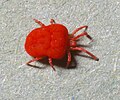Trombiculidae
Trombiculidae[edit]

Trombiculidae, commonly known as chiggers, are a family of mites in the order Trombidiformes. These mites are known for their larval stage, which can cause intense itching and dermatitis in humans and animals. The larvae are parasitic, feeding on the skin cells of their hosts.
Description[edit]

Trombiculidae mites are small, with adults measuring about 1 to 2 mm in length. The larvae, which are the only parasitic stage, are even smaller, typically less than 0.3 mm. They are usually red or orange in color, which makes them visible to the naked eye. The larvae have six legs, while the nymphs and adults have eight legs.
Life Cycle[edit]

The life cycle of Trombiculidae includes four stages: egg, larva, nymph, and adult. The eggs are laid in the soil, and upon hatching, the larvae seek out a host to feed on. After feeding, the larvae drop off the host and develop into nymphs, which eventually mature into adults. The adults are free-living and feed on small arthropods and their eggs.
Parasitic Behavior[edit]

The larval stage of Trombiculidae is parasitic. The larvae attach to the skin of their host and inject digestive enzymes that break down skin cells. They do not burrow into the skin but remain on the surface, feeding through a stylostome, a tube-like structure formed by the host's skin in response to the mite's saliva.
Effects on Humans[edit]

Chigger bites can cause intense itching and dermatitis, known as trombiculosis. The itching is due to the body's allergic reaction to the mite's saliva. The bites often appear as red, raised bumps and can be extremely itchy. Scratching can lead to secondary infections.
Prevention and Treatment[edit]
To prevent chigger bites, it is recommended to avoid walking through tall grass and brush where chiggers are common. Wearing long sleeves and pants, and using insect repellent can also help. If bitten, over-the-counter anti-itch creams and antihistamines can provide relief. Keeping the affected area clean can prevent infection.
Related Pages[edit]
-
Trombicula mite larva with stylostome
-
Harvest mite life cycle
-
Chigger bite illustration
-
Adult Trombicula mite
-
Trombiculosis sores
-
Trombiculid mite larvae attached to human skin
Ad. Transform your life with W8MD's Budget GLP-1 injections from $75


W8MD offers a medical weight loss program to lose weight in Philadelphia. Our physician-supervised medical weight loss provides:
- Weight loss injections in NYC (generic and brand names):
- Zepbound / Mounjaro, Wegovy / Ozempic, Saxenda
- Most insurances accepted or discounted self-pay rates. We will obtain insurance prior authorizations if needed.
- Generic GLP1 weight loss injections from $75 for the starting dose.
- Also offer prescription weight loss medications including Phentermine, Qsymia, Diethylpropion, Contrave etc.
NYC weight loss doctor appointmentsNYC weight loss doctor appointments
Start your NYC weight loss journey today at our NYC medical weight loss and Philadelphia medical weight loss clinics.
- Call 718-946-5500 to lose weight in NYC or for medical weight loss in Philadelphia 215-676-2334.
- Tags:NYC medical weight loss, Philadelphia lose weight Zepbound NYC, Budget GLP1 weight loss injections, Wegovy Philadelphia, Wegovy NYC, Philadelphia medical weight loss, Brookly weight loss and Wegovy NYC
|
WikiMD's Wellness Encyclopedia |
| Let Food Be Thy Medicine Medicine Thy Food - Hippocrates |
Medical Disclaimer: WikiMD is not a substitute for professional medical advice. The information on WikiMD is provided as an information resource only, may be incorrect, outdated or misleading, and is not to be used or relied on for any diagnostic or treatment purposes. Please consult your health care provider before making any healthcare decisions or for guidance about a specific medical condition. WikiMD expressly disclaims responsibility, and shall have no liability, for any damages, loss, injury, or liability whatsoever suffered as a result of your reliance on the information contained in this site. By visiting this site you agree to the foregoing terms and conditions, which may from time to time be changed or supplemented by WikiMD. If you do not agree to the foregoing terms and conditions, you should not enter or use this site. See full disclaimer.
Credits:Most images are courtesy of Wikimedia commons, and templates, categories Wikipedia, licensed under CC BY SA or similar.
Translate this page: - East Asian
中文,
日本,
한국어,
South Asian
हिन्दी,
தமிழ்,
తెలుగు,
Urdu,
ಕನ್ನಡ,
Southeast Asian
Indonesian,
Vietnamese,
Thai,
မြန်မာဘာသာ,
বাংলা
European
español,
Deutsch,
français,
Greek,
português do Brasil,
polski,
română,
русский,
Nederlands,
norsk,
svenska,
suomi,
Italian
Middle Eastern & African
عربى,
Turkish,
Persian,
Hebrew,
Afrikaans,
isiZulu,
Kiswahili,
Other
Bulgarian,
Hungarian,
Czech,
Swedish,
മലയാളം,
मराठी,
ਪੰਜਾਬੀ,
ગુજરાતી,
Portuguese,
Ukrainian





